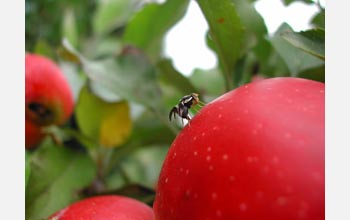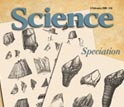News Release 09-018
Researchers Observe Evolution Chain Reaction
North American apples prompt genetic changes in fruit flies and parasitic wasps

A female apple maggot fly, Rhagoletis pomonella, implants an egg into an apple.
February 5, 2009
View a video interview with Jeffrey Feder, a University of Notre Dame biologist.
This material is available primarily for archival purposes. Telephone numbers or other contact information may be out of date; please see current contact information at media contacts.
A team of researchers is reporting the ongoing emergence of a new species of fruit fly--and the sequential development of a new species of wasp--in the February 6 issue of the journal Science.
Jeff Feder, a University of Notre Dame biologist, and his colleagues say the introduction of apples to America almost 400 years ago ultimately may have changed the behavior of a fruit fly, leading to its modification and the subsequent modification of a parasitic wasp that feeds on it.
The result is a chain reaction of biodiversity where the modification of one species triggers the sequential modification of a second, dependent species. The National Science Foundation supports the research.
"It's a nice demonstration of how the initial speciation of one organism opens up an opportunity for another species in the ecosystem to speciate in kind," said Feder. "Biodiversity in essence is the source for new biodiversity."
For almost 250 years after the introduction of apples to North America, insects referred to as hawthorn flies, Rhagoletis pomonella, continued to meet on the small, red fruit of hawthorn trees to mate and lay eggs. Then, in the mid-1800s, some of these "hawthorn flies" began to mate and lay eggs on apples instead. According to Feder, the flies attracted to apples eventually became genetically differentiated from the flies attracted to hawthorns, and so did the wasps that live on the flies' larvae.
The genetic distinctions mainly show up as gene frequency differences between the flies and their associated wasp populations rather than fixed, all or none, differences. This is consistent with the process by which new biological species arise.
"The Diachasma alloeum wasp that we studied is just one of several wasps that spend a significant portion of their lives attached to hawthorn and apple flies," said Feder. "We have preliminary evidence that one of the other wasps also may be forming specialized races on the flies, but it is too early to tell definitively."
"What is startling is how fast populations can ecologically adapt to new habitats and begin to evolve into different species in front of our eyes," he said.
Feder says the research is important because it provides insights into solving Darwin's mystery of the origins of new species. "Clues can be found right before us as we sit on our deck chairs barbecuing and drinking pop. All we have to do is open our eyes and we can see new life forms coming into being in that scraggly old apple tree in our backyard."
Notre Dame biologists Andrew Forbes and Tom Powell, along with University of Florida entomologist Lukasz Stelinski and Michigan State University biologist James Smith also worked on this project.
-NSF-
-
View Video
Dr. Jeffrey Feder discusses the genetic chain reaction between apple flies and parasitic wasps.
Credit and Larger Version -
Feb. 6, 2009, cover of the journal Science.
Credit and Larger Version
Media Contacts
Bobbie Mixon, NSF, (703) 292-8485, email: bmixon@nsf.gov
Program Contacts
Nancy J. Huntly, NSF, email: nhuntly@nsf.gov
Principal Investigators
Jeffrey L. Feder, University of Notre Dame, (574) 631-4159, email: jfeder@nd.edu
The U.S. National Science Foundation propels the nation forward by advancing fundamental research in all fields of science and engineering. NSF supports research and people by providing facilities, instruments and funding to support their ingenuity and sustain the U.S. as a global leader in research and innovation. With a fiscal year 2023 budget of $9.5 billion, NSF funds reach all 50 states through grants to nearly 2,000 colleges, universities and institutions. Each year, NSF receives more than 40,000 competitive proposals and makes about 11,000 new awards. Those awards include support for cooperative research with industry, Arctic and Antarctic research and operations, and U.S. participation in international scientific efforts.
Connect with us online
NSF website: nsf.gov
NSF News: nsf.gov/news
For News Media: nsf.gov/news/newsroom
Statistics: nsf.gov/statistics/
Awards database: nsf.gov/awardsearch/
Follow us on social
Twitter: twitter.com/NSF
Facebook: facebook.com/US.NSF
Instagram: instagram.com/nsfgov


